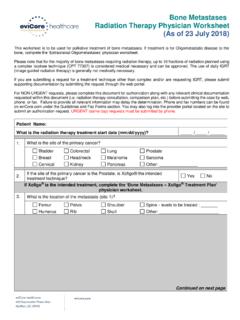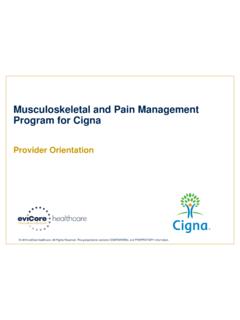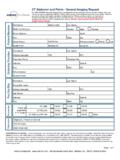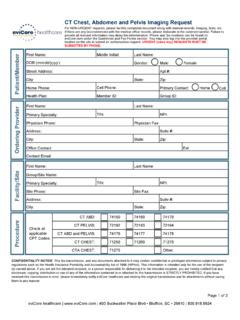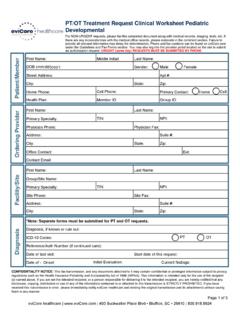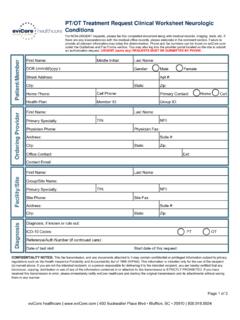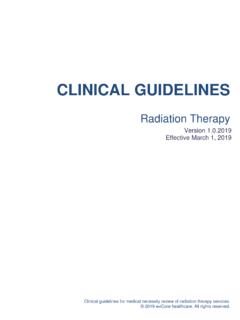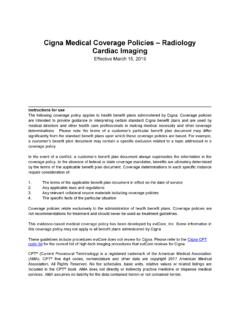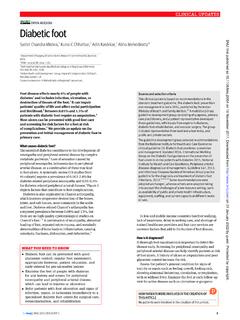Transcription of eviCore Spine Imaging Guidelines
1 Spine Imaging Guidelines Version Effective January 1, 2022 2021 eviCore healthcare. All rights reserved. CLINICAL Guidelines eviCore healthcare Clinical Decision Support Tool Diagnostic Strategies: This tool addresses common symptoms and symptom complexes. Imaging requests for individuals with atypical symptoms or clinical presentations that are not specifically addressed will require physician review. Consultation with the referring physician, specialist and/or individual s Primary Care Physician (PCP) may provide additional insight. eviCore s Clinical Review Criteria ( CRC ) and related content is made available for the limited uses of: reference; and individual use, only limited to facilitating the determination of medically necessary and appropriate clinical treatment by clinicians for specific delegated patients under their care. The CRC and related content is proprietary information of eviCore , and copyrighted to the full extent of the law.
2 Except as expressly permitted, you may not modify, copy, reproduce, republish, upload, post, transmit, hyperlink to or from, or distribute in any way the CRC, nor may you sell, transfer, distribute, assign, lease, reproduce, or otherwise use the CRC in commerce, in a manner that competes with us or infringes upon our rights, or for any public or commercial endeavor without our prior and express written (Current Procedural Terminology) is a registered trademark of the American Medical Association (AMA). CPT five digit codes, nomenclature and other data are copyright 2021 American Medical Association. All Rights Reserved. No fee schedules, basic units, relative values or related listings are included in the CPT book. AMA does not directly or indirectly practice medicine or dispense medical services. AMA assumes no liability for the data contained herein or not contained herein. Spine Imaging GuidelinesProcedure Codes Associated with Spine Imaging 3SP-1: General Guidelines 5SP-2: Imaging Techniques 15SP-3: Neck (Cervical Spine ) Pain Without/With Neurological Features (Including Stenosis) and Trauma 23SP-4: Upper Back (Thoracic Spine ) Pain Without/With Neurological Features (Including Stenosis) and Trauma 27SP-5: Low Back (Lumbar Spine ) Pain/Coccydynia without Neurological Features 30SP-6: Lower Extremity Pain with Neurological Features (Radiculopathy, Radiculitis, or Plexopathy and Neuropathy) With or Without Low Back (Lumbar Spine ) Pain 33SP-7: Myelopathy 37SP-8: Lumbar Spine Spondylolysis/Spondylolisthesis 40SP-9: Lumbar Spinal Stenosis 43SP-10: Sacro-Iliac (SI) Joint Pain, Inflammatory Spondylitis/Sacroiliitis and Fibromyalgia 45SP-11: Pathological Spinal Compression Fractures 48SP-12: Spinal Pain in Cancer Patients 50SP-13: Spinal Canal/Cord Disorders ( Syringomyelia) 51SP-14.
3 Spinal Deformities ( Scoliosis/Kyphosis) 53SP-15: Post-Operative Spinal Disorders 55SP-16: Other Imaging Studies and Procedures Related to the Spine Imaging Guidelines 58SP-17: Nuclear Medicine 61 Page 2 of 62 Spine Imaging Guidelines _____ 2021 eviCore healthcare. All Rights Reserved. 400 Buckwalter Place Boulevard, Bluffton, SC 29910 (800) 918-8924 Spine Imaging Guidelines Procedure Codes Associated with Spine Imaging MRI/MRA CPT Cervical MRI without contrast 72141 Cervical MRI with contrast 72142 Cervical MRI without and with contrast 72156 Thoracic MRI without contrast 72146 Thoracic MRI with contrast 72147 Thoracic MRI without and with contrast 72157 Lumbar MRI without contrast 72148 Lumbar MRI with contrast 72149 Lumbar MRI without and with contrast 72158 Spinal Canal MRA 72159 MRI Pelvis without contrast 72195 MRI Pelvis with contrast 72196 MRI Pelvis without and with contrast 72197 MR Spectroscopy 76390 Magnetic resonance spectroscopy, determination and localization of discogenic pain (cervical, thoracic, or lumbar).
4 Acquisition of single voxel data, per disc, on biomarkers (ie, lactic acid, carbohydrate, alanine, laal, propionic acid, proteoglycan, and collagen) in at least 3 discs 0609T Magnetic resonance spectroscopy, determination and localization of discogenic pain (cervical, thoracic, or lumbar); transmission of biomarker data for software analysis 0610T Magnetic resonance spectroscopy, determination and localization of discogenic pain (cervical, thoracic, or lumbar); postprocessing for algorithmic analysis of biomarker data for determination of relative chemical differences between discs 0611T Magnetic resonance spectroscopy, determination and localization of discogenic pain (cervical, thoracic, or lumbar); interpretation and report 0612T CT CPT Cervical CT without contrast 72125 Cervical CT with contrast (Post-Myelography CT) 72126 Cervical CT without and with contrast 72127 Thoracic CT without contrast 72128 Thoracic CT with contrast (Post-Myelography CT) 72129 Thoracic CT without and with contrast 72130 Lumbar CT without contrast (Post-Discography CT) 72131 Lumbar CT with contrast (Post-Myelography CT) 72132 Lumbar CT without and with contrast 72133 CT Pelvis without contrast 72192 CT Pelvis with contrast 72193 CT Pelvis without and with contrast 72194 Page 3 of 62 Spine Imaging Guidelines .
5 2022 _____ 2021 eviCore healthcare. All Rights Reserved. 400 Buckwalter Place Boulevard, Bluffton, SC 29910 (800) 918-8924 Spine Imaging Guidelines Ultrasound CPT Spinal canal ultrasound 76800 Nuclear Medicine CPT Bone Marrow Imaging , Limited 78102 Bone Marrow Imaging , Multiple 78103 Bone Marrow Imaging , Whole Body 78104 Bone or Joint Imaging , Limited 78300 Bone or Joint Imaging , Multiple 78305 Bone Scan, Whole Body 78306 Bone Scan, 3 Phase Study 78315 Radiopharmaceutical localization of tumor, inflammatory process or distribution of radiopharmaceutical agent(s) (includes vascular flow and blood pool Imaging , when performed); planar, single area ( , head, neck, chest, pelvis), single day Imaging 78800 Radiopharmaceutical localization of tumor, inflammatory process or distribution of radiopharmaceutical agent(s) (includes vascular flow and blood pool Imaging , when performed); planar, 2 or more areas ( , abdomen and pelvis, head and chest), 1 or more days Imaging or single area Imaging over 2 or more days 78801 Radiopharmaceutical localization of tumor, inflammatory process or distribution of radiopharmaceutical agent(s) (includes vascular flow and blood pool Imaging , when performed); planar, whole body, single day Imaging 78802 Radiopharmaceutical localization of tumor, inflammatory process or distribution of radiopharmaceutical agent(s) (includes vascular flow and blood pool Imaging , when performed); tomographic (SPECT), single area ( , head, neck, chest, pelvis), single day Imaging 78803 Radiopharmaceutical localization of tumor, inflammatory process or distribution of radiopharmaceutical agent(s) (includes vascular flow and blood pool Imaging , when performed).
6 Tomographic (SPECT) with concurrently acquired computed tomography (CT) transmission scan for anatomical review, localization and determination/detection of pathology, single area ( , head, neck, chest, pelvis), single day Imaging 78830 Radiopharmaceutical localization of tumor, inflammatory process or distribution of radiopharmaceutical agent(s) (includes vascular flow and blood pool Imaging , when performed); tomographic (SPECT), minimum 2 areas ( , pelvis and knees, abdomen and pelvis), single day Imaging , or single area Imaging over 2 or more days 78831 Page 4 of 62 Spine Imaging Guidelines _____ 2021 eviCore healthcare. All Rights Reserved. 400 Buckwalter Place Boulevard, Bluffton, SC 29910 (800) 918-8924 Spine Imaging Guidelines SP-1: General Guidelines : General Guidelines 6 : General Considerations 8 : Red Flag Indications 9 : Definitions 13 Page 5 of 62 Spine Imaging Guidelines _____ 2021 eviCore healthcare.
7 All Rights Reserved. 400 Buckwalter Place Boulevard, Bluffton, SC 29910 (800) 918-8924 Spine Imaging Guidelines : General Guidelines Before advanced diagnostic Imaging can be considered, there must be an initial face-to-face clinical evaluation as well as a clinical re-evaluation after a trial of failed conservative therapy; the clinical re-evaluation may consist of a face-to-face evaluation or other meaningful contact with the provider s office such as email, web or telephone communications. A face-to-face clinical evaluation is required to have been performed within the last 60 days before advanced Imaging is considered. This may have been either the initial clinical evaluation or a clinical re-evaluation. The initial clinical evaluation should include a relevant history and physical examination (including a detailed neurological examination), appropriate laboratory studies, non-advanced Imaging modalities, results of manual motor testing, the specific dermatomal distribution of altered sensation, reflex examination, and nerve root tension signs ( , straight leg raise test, slump test, femoral nerve tension test).
8 The initial clinical evaluation must be face-to-face; other forms of meaningful contact (telephone call, electronic mail or messaging) are not acceptable as an initial evaluation. For those spinal conditions/disorders for which the Spine Imaging Guidelines require a plain x-ray of the Spine prior to consideration of an advanced Imaging study, the plain x-ray must be performed after the current episode of symptoms started or changed (see: : Anatomic Guidelines ). Clinical re-evaluation is required prior to consideration of advanced diagnostic Imaging to document failure of significant clinical improvement following a recent (within 3 months) six week trial of provider-directed treatment. Clinical re-evaluation can include documentation of a face-to-face encounter or documentation of other meaningful contact with the requesting provider s office by the patient ( , telephone call, electronic mail or messaging). Provider-directed treatment may include education, activity modification, NSAIDs (non-steroidal anti-inflammatory drugs), narcotic and non-narcotic analgesic medications, oral or injectable corticosteroids, a provider-directed home exercise/stretching program, cross-training, avoidance of aggravating activities, physical/occupational therapy, spinal manipulation, interventional pain procedures and other pain management techniques.
9 Any bowel/bladder abnormalities or emergent or urgent indications should be documented at the time of the initial clinical evaluation and clinical re-evaluation. Altered sensation to pressure, pain, and temperature should be documented by the specific anatomic distribution ( , dermatomal, stocking/glove or mixed distribution). Motor deficits (weakness) should be defined by the specific myotomal distribution ( , weakness of toe flexion/extension, knee flexion/extension, ankle dorsi/ plantar flexion, wrist dorsi/palmar flexion) and gradation of muscle testing should be documented as follows: Page 6 of 62 Spine Imaging Guidelines _____ 2021 eviCore healthcare. All Rights Reserved. 400 Buckwalter Place Boulevard, Bluffton, SC 29910 (800) 918-8924 Spine Imaging Guidelines Grading of Manual Muscle Testing 0 No evidence of muscle function 1 Muscle contraction but no or very limited joint motion 2 Movement possible with gravity eliminated 3 Movement possible against gravity 4 Movement possible against gravity with some resistance 5 Movement possible against gravity with full or normal resistance Pathological reflexes ( Hoffmann s, Babinski, and Chaddock sign) should be reported as positive or negative.
10 Asymmetric reflexes and reflex examination should be documented as follows: Grading of Reflex Testing 0 No response 1+ A slight but definitely present response 2+ A brisk response 3+ A very brisk response without clonus 4+ A tap elicits a repeating reflex (clonus) Advanced diagnostic Imaging is often urgently indicated and may be necessary if serious underlying spinal and/or non-spinal disease is suggested by the presence of certain patient factors referred to as red flags. See : Red Flag Indications. Spinal specialist evaluation can be helpful in determining the need for advanced diagnostic Imaging , especially for patients following spinal surgery. The need for repeat advanced diagnostic Imaging should be carefully considered and may not be indicated if prior advanced diagnostic Imaging has been performed. Requests for simultaneous, similar studies such as spinal MRI and CT need to be documented as required for preoperative surgical planning.
